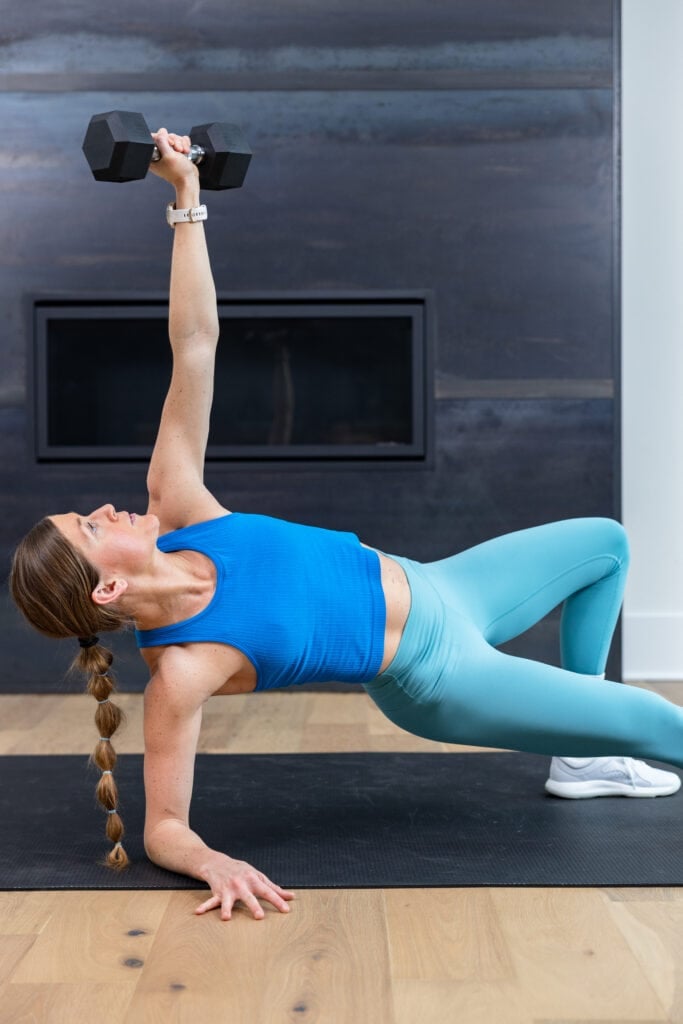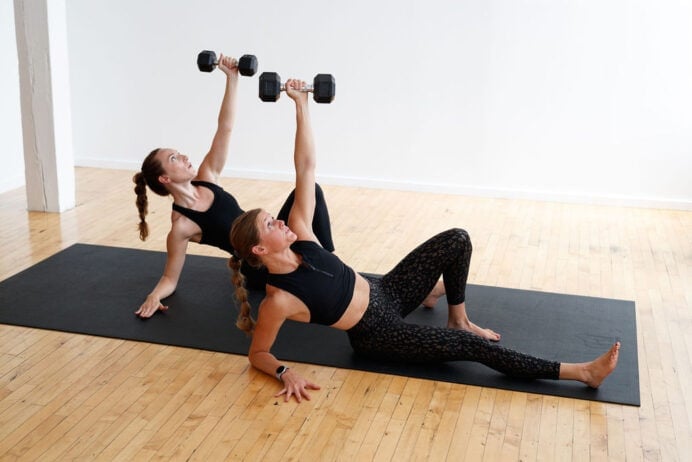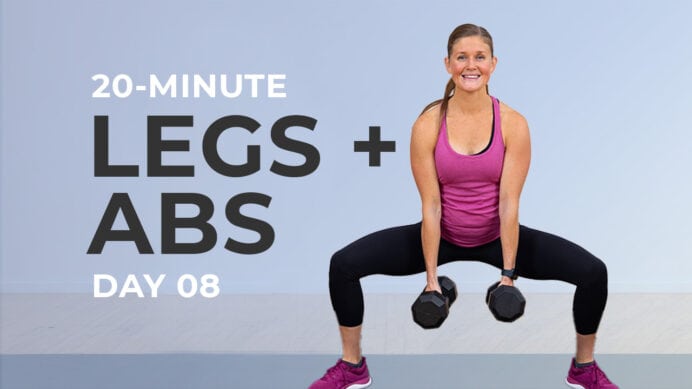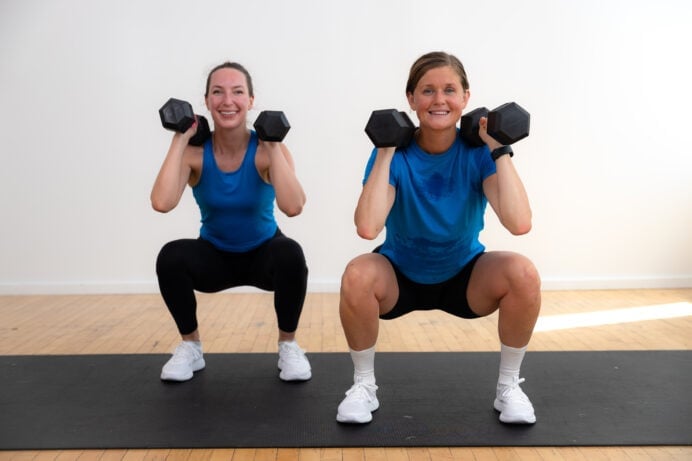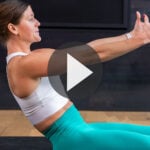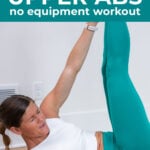

7 Best Upper Ab Exercises (No Equipment)
Strengthen and define the abs with this quick, no-repeats workout: the seven best upper ab exercises. This upper ab workout strengthens the largest and most visible part of the core, improving stability, posture and overall ab definition.
As a personal trainer, I’m often asked what’s the “trick” to toning the abs and core.
In my opinion, the best way to build strong, defined abs is to functionally train the muscles that criss-cross around the trunk of your body. Functional core training is built into nearly all of our workouts, but if you’re looking to specifically improve core strength and definition, it can be beneficial to add in targeted ab workouts a few times a week.
Our ab workouts are some of our most popular workouts on the blog. We’ve previously shared our favorite Lower Ab Exercises, Oblique Exercises and Transverse Abdominis Exercises. Today’s workout shifts the focus to the upper abs.
The upper and lower abs are all part of one large muscle called the rectus abdominis, running from the top of our rib cages to our hips.
This is the muscle being referred to when people talk about “six-pack” muscles.
The upper abdominals are the most visible part of this muscle, and specifically training them can not only increase muscle definition, but also improve core stability and posture.

7-Minute Upper Ab Workout
Seven upper ab exercises to strengthen your core and add muscle definition to your midsection.
Add this upper abs workout to your weekly workout routine 1-2 times a week to build muscle and improve definition in the abdominal muscles.
Workout Equipment:
No equipment, just your body weight. Option to increase the intensity by adding a dumbbell or kettlebell.
Workout Instructions:
Follow along with the guided Upper Ab Workout Video on YouTube, led by certified personal trainer Lindsey Bomgren.
Your Workout Looks Like This:
- 7 Upper Ab Exercises
- Timed Intervals (40 seconds of work, 20 seconds of rest. Perform as many reps as possible with good form within the timed interval)
- Perform Each Upper Ab Exercise x1 (no repeats)

Prefer to Watch On YouTube?
Workout Outline
- Pilates Roll Up
- Butterfly Crunches
- Arms-Only Dead Bug and Heel Reach
- Alternating Toe Touches
- Leg Climb Crunches
- Table Top Crossovers
- Half Crunch and Table Top Hold
7 Best Upper Ab Exercises
Pilates Roll Up (Full Sit-Up)
Targets: Upper abs, transversus abdominis, erector spinae and hips.
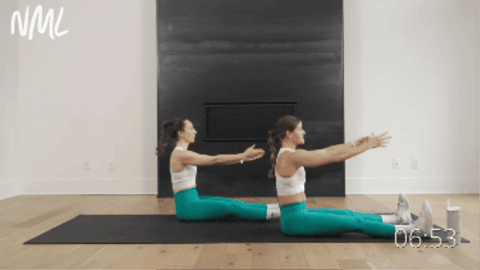
How To Do Pilates Roll Ups (Full Sit-Ups)
- Lie flat on your back, legs extended out long. Reach your arms overhead, palms facing in towards each other, hands shoulder width apart. Press your lower back into the mat.
- Exhale as you slowly roll up, thinking of peeling your upper body off the mat one vertebrae at a time. Aim to be seated tall at the top of the movement, shoulders stacked over hips and spine long. Aim to keep your arms reaching out in front of you, soft bends in each elbow.
- Slowly and with control, lower your upper body to the mat, rolling down one vertebrae at a time, returning to starting position.
Modification: Reduce range of motion, leaning back only until you feel your abs engage, then returning to a seated position.
Butterfly Crunch
Targets: Upper abs, erector spinae and hips.

How To Do Butterfly Crunches
- Lie flat on your back. Bring the soles of your feet to touch, knees wide (butterfly pose). Option to place your fingertips lightly behind your head.
- Keeping your low back pressed into the floor (performing a slight pelvic tilt), brace your core and exhale as you slowly lift your head, neck and shoulder blades off the mat.
- With control, slowly lower first your shoulders, then neck, then head to the mat, returning to starting position.
Arms-Only Dead Bug and Heel Reach
Targets: Upper abs, transversus abdominis (deep core muscles below your rectus abdomen or six pack ab muscles), and hip flexors.
The dead bug is one of the best ab exercises for women.

How To Do Arms-Only Dead Bugs and Heel Reaches
- Lie flat on the mat, performing a slight pelvic tilt to press your lower back into the mat and drawing your belly button towards your spine. Think about wrapping your abdominal wall around your torso.
- Then bring your legs up, knees bent at 90 degrees, shins parallel to the floor. Extend your arms straight overhead, wrists stacked over shoulders.
- Contract your ab muscles to engage your core as you extend your right arm overhead, away from your heels. Exhale to bring your right arm back to center.
- Then, squeeze through the upper abs to lift your head, neck and shoulders off the mat as you reach with both hands to tap your heels.
- With control, lower your upper body to the mat, returning to starting position.
- Repeat, this time extending your left arm overhead.
Modification: Omit the heel reach, performing just arms-only dead bugs.
Alternating Toe Touch
Targets: Upper abs, transversus abdominis, obliques and hips.
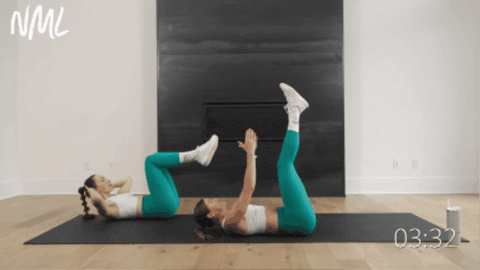
How To Do Alternating Toe Touches
- Lie flat on the mat, performing a slight pelvic tilt to press your lower back into the mat and drawing your belly button towards your spine.
- Then bring your legs up, extending your legs straight over your hips and pointing your toes. Extend your arms straight overhead, wrists stacked over shoulders.
- Squeeze through your upper abs to lift your head, neck and shoulders off the mat as you reach your right hand outside of your left shin. Think about lifting your right shoulder as far off the mat as you can, engaging your side abs.
- With control, lower your upper body to the mat, returning to starting position.
- Repeat, this time reaching your left fingers outside of your right shin on an exhale, before inhaling to return to the starting position.
Modification: Bend your knees, reducing the range of motion.
Leg Climb Crunch
Targets: Upper abs, transversus abdominis, glutes, lower abs and hip flexors.

How To Do Leg Climb Crunches
- Lay flat on your back, legs extended long away from your body. Press your lower back into the mat to engage your core.
- Send your right leg straight up in the air, toes stacked over hip, slight bend in the knee. Lift the left leg off the mat, hovering your foot a few inches off the ground.
- Place your hands on your right thigh, then use your abs and core to lift yourself upwards, “climbing” up your right leg with your hands as you raise your head and neck off the mat.
- Inhale as you reverse the movement, lowering your upper body to the ground and returning to starting position before switching legs.
Modification: Keep the heel of your opposite leg (the leg you are not climbing) on the ground rather than floating it.
Table Top Crossover Crunch
Targets: Rectus abdominis, transversus abdominis and obliques.

How To Do Table Top Crossover Crunches
- Lie flat on the mat, performing a slight pelvic tilt to press your lower back into the mat and drawing your belly button towards your spine.
- Then bring your legs up, both knees bent at 90 degrees, shins parallel to the floor. Extend your arms straight overhead, wrists stacked over shoulders. Press the palms of your hands together.
- Inhale to prepare, then exhale as you reach your fingertips outside of your left shin, lifting your head, neck and shoulders off the mat as you reach up and forward.
- Inhale as you lower your upper body to the mat, returning to starting position.
- Repeat, this time reaching your fingertips straight up above your knees before lowering to the mat.
- Repeat again, this time reaching your fingertips to the outside of your right shin, squeezing through your upper and side abs to lift your opposite left shoulder off the mat.
Modification: Keep feet planted on the ground, knees bent, to reduce range of motion.
Half Crunch and Table Top Hold
Targets: Rectus abdominis, lower abs, transverse abdominis and pelvic floor.

How To Do Half Crunches and Table Top Hollow Rock Holds
- Lie flat on the mat, performing a slight pelvic tilt to press your lower back into the mat and drawing your belly button towards your spine. Feet are planted on the floor, knees bent. Option to lightly press your fingertips into the back of your head, elbows wide.
- Squeeze through your upper abs to lift your head, neck and shoulders off the mat, crunching through the core. Think about reducing the amount of space between the bottom of your ribs and your hips.
- Repeat, performing three crunches.
- Then, keeping your upper body raised off the mat and core engaged, bring your legs up, both knees bent at 90 degrees, shins parallel to the floor.
- Hold this table top hollow rock hold for a three-count, before lowering your head, neck and shoulders to the mat, returning to starting position.
Upper Ab Exercises FAQs
Crunch variations and plank variations are two of the most popular ways to work the upper abs. Exercises that curl your spine forward, like crunches, tend to activate the upper abs more. This is because the upper abs contract to bring your ribs closer to your pelvis. Whereas exercises that bring your legs towards your torso (such as leg raises) tend to engage the lower abs.
Visible abs are due to a combination of strengthening the actual core muscles and having relatively low body fat percentage. Abs are built through a combination of targeted isolation exercises (such as lower ab exercises and oblique exercises) as well as complete functional core exercises targeting multiple ab muscles at once.
A strong core is important for so many reasons. According to Mayo Clinic, a strong core is tied to improved balance and stability, improved posture, reduced risk of lower back pain, and reduced risk of injuries (especially from activities that involve core rotation).
Your abs are a muscle group that require rest and recovery time, just like any of your other major muscle groups. Overtraining can lead to muscle imbalances, burnout and injury. For the best results, follow a well-rounded workout program that builds in core training 2-3 times a week.
More Workouts
Abs + Core WorkoutsPin This Workout: 7 Best Upper Ab Exercises
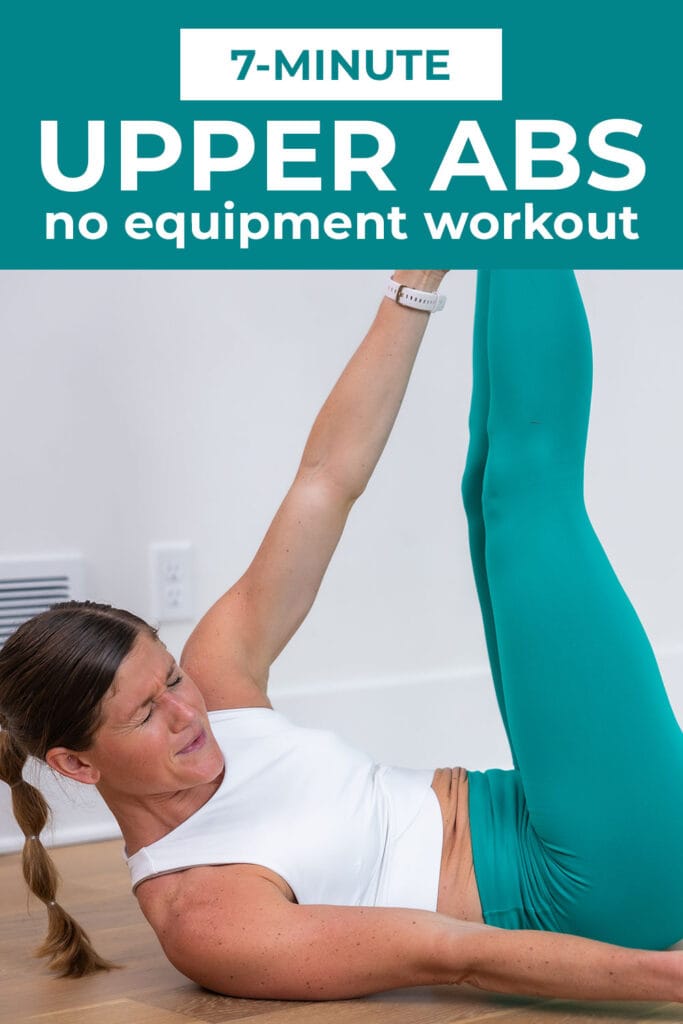
This post includes affiliate links. I do earn a commission for products purchased using these links (at no additional cost to you). Thank you for supporting Nourish Move Love, making the content you see on this blog possible.










